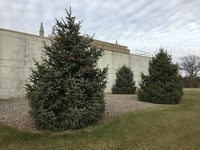Dakota Gardener: A million miles an hour
(Click an image below to view a high-resolution image that can be downloaded)
By Joe Zeleznik, Forester
NDSU Extension
My wife and I took care of our five-year-old grandson last week.
It was a blast but we’re exhausted.
We went to two different parks, a children’s science museum (three times!), took him fishing and even played a game of tag on his last morning with us. He’s going through a growth spurt as well, and he had a big appetite. Each day, he burned that food energy with lots of running around and activity. Go, go, go.
In trees’ first few years, they’re establishing themselves, developing their crowns and their root systems. The rings are very small right near the center of the tree.
Once established, though, instead of go, go, go, it’s grow, grow, grow. The trees enter their “juvenile growth phase.” The rings are very wide as the trees put on a lot of wood each year. Picture a teenager going through a growth spurt.
That juvenile growth phase in the tree rings can last 10 or 20 years, or even longer. Eventually, ring sizes get smaller and stabilize, fluctuating only slightly with small year-to-year variation.
Our grandson’s growth will level off at some point, too. Until then, he’s going to go a million miles an hour. At the playground, he bounced from one piece of equipment to the next to the next to the next. He has the attention span of, well, a five-year-old!
The shifting priorities of a child do have an analogy in trees. Obviously, the juvenile trees aren’t running around on the playground. They’re not climbing the jungle gym or going down the slide, but they also have shifting priorities in where they burn their energy.
Trees are stretching new growth towards the sun, trying to out-compete their neighbors for this precious resource. New roots extend in every direction as trees attempt to gain more water and nutrients than the others. If trees are attacked by insects or diseases, they have to put more energy into defense than into growth. If our grandson gets sick, his body burns energy trying to get rid of the infection, rather than using it for growth.
The vascular system of a tree is vastly different than an animal’s, and trees are generally slower to respond to threats. Nevertheless, they do respond eventually and produce the biochemicals that fight off insects and diseases. But how do they decide where to put their energy and nutrients?
Internally, we think of energy sources and sinks. The energy sources are the leaves, making sugar during photosynthesis. The sinks are those areas that are demanding energy – like growing new leaves or fighting off an insect. Each of those sinks is pulling energy towards them, and there’s an internal competition. It’s a matter of shifting priorities, but on the inside.
Eventually, our grandson will grow into an adolescent and someday into an adult. Those juvenile trees will mature as well. The word maturity has many meanings and is different between humans and trees.
People often describe a tree as being “mature,” and then they tell me how tall the tree is. Some folks consider a 20-foot-tall tree to be mature, while others wouldn’t use that term until a tree is 40 feet or even taller.
For tree physiology, we say that trees are mature once they begin to reproduce. That will occur when trees reach some certain minimum size. It’s actually not an age thing with trees. Some trees will reproduce in as little as 10 years, while others take 40 years or longer to mature.
We’re enjoying the juvenile phase that our grandson is in. It is exciting and exhausting but we wouldn’t trade it for the world.
NDSU Agriculture Communication – July 25, 2023
Source: Joe Zeleznik, 701-730-3389, joseph.zeleznik@ndsu.edu
Editor: Kelli Anderson, 701-231-7881, kelli.c.anderson@ndsu.edu




